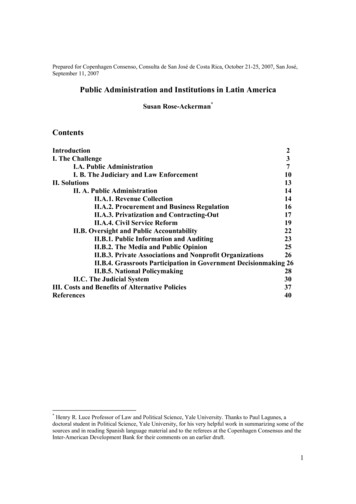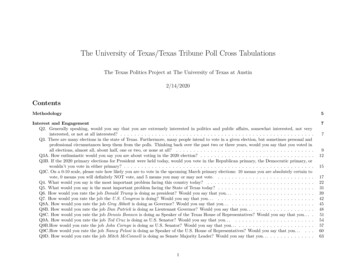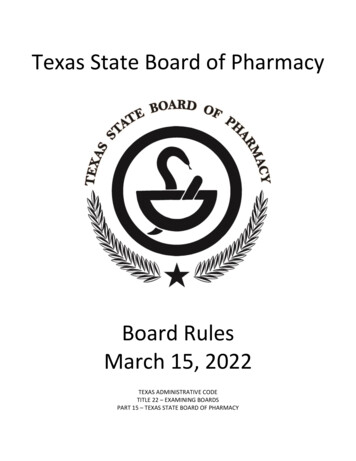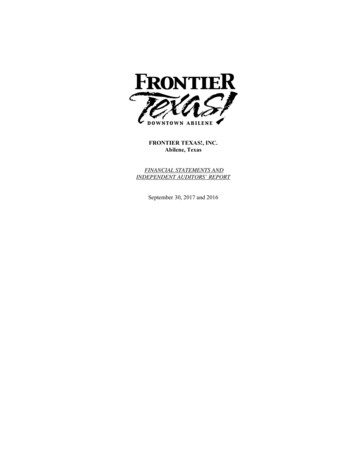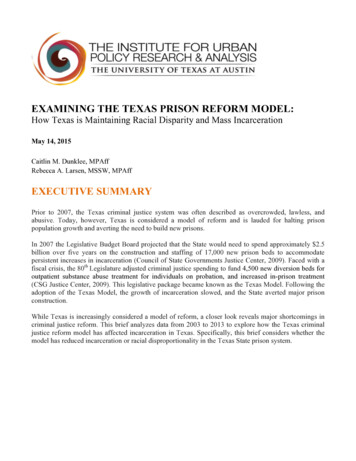
Transcription
EXAMINING THE TEXAS PRISON REFORM MODEL:How Texas is Maintaining Racial Disparity and Mass IncarcerationMay 14, 2015Caitlin M. Dunklee, MPAffRebecca A. Larsen, MSSW, MPAffEXECUTIVE SUMMARYPrior to 2007, the Texas criminal justice system was often described as overcrowded, lawless, andabusive. Today, however, Texas is considered a model of reform and is lauded for halting prisonpopulation growth and averting the need to build new prisons.In 2007 the Legislative Budget Board projected that the State would need to spend approximately 2.5billion over five years on the construction and staffing of 17,000 new prison beds to accommodatepersistent increases in incarceration (Council of State Governments Justice Center, 2009). Faced with afiscal crisis, the 80th Legislature adjusted criminal justice spending to fund 4,500 new diversion beds foroutpatient substance abuse treatment for individuals on probation, and increased in-prison treatment(CSG Justice Center, 2009). This legislative package became known as the Texas Model. Following theadoption of the Texas Model, the growth of incarceration slowed, and the State averted major prisonconstruction.While Texas is increasingly considered a model of reform, a closer look reveals major shortcomings incriminal justice reform. This brief analyzes data from 2003 to 2013 to explore how the Texas criminaljustice reform model has affected incarceration in Texas. Specifically, this brief considers whether themodel has reduced incarceration or racial disproportionality in the Texas State prison system.
The findings of this analysis show: Since the establishment of the Texas prison reform model, the State has failed to reduce thenumber of individuals it incarcerates or significantly decrease racial disproportionality. Thesefailures call into question the effectiveness of the Texas Model of prison reform.Texas continues to imprison more people than any other state, driving the nation’s incarcerationrate. While Texas’s rate of incarceration has dropped during the last seven years, it still ranksfifth highest in the nation, and first among the most populous states.In 2013, Texas increased the number of people it incarcerates, despite national trends thatindicated decreased incarceration in several of the most populous states.Texas continues to disproportionately incarcerate African Americans.The Texas Model was developed to save taxpayer dollars. While cost savings is a compellingcomponent of prison reform, fiscal austerity reform designs fail to address the underlying driversof mass incarceration.In 2014, Pew Charitable Trusts found that the states that reduced incarceration the mostexperienced the greatest decline in crime rates (Pew, 2014).In light of these findings, Texas has an opportunity to set a new course for effective and equitablereform. Specifically, Texas can:1) reduce the number of individuals living in prison by addressing the underlying causes of massincarceration, 2) replace the Texas Department of Criminal Justice’s antiquated racial classificationsystem with a self-identification system that more accurately gathers information about both race andethnicity, and 3) mandate that racial impact statements be produced for all proposed criminal justicelegislation.INCARCERATION IN A NATIONAL CONTEXTPrior to the 1970s, the United Statesincarcerated 2.2 million people, and anincarceration rate remained at about 100 perestimated 4.7 million people were on probation100,000residents Several states, including New York, and parole (Bureau of(Perkinson, 2012, p.Justice Statistics, 2014).302). In 1968, however, New Jersey, and California, have According to the National“law and order” became substantially reduced incarceration Academy of Sciences, “thea preeminent political through a range of means, including growth in incarcerationissue in the presidential sentencing reform.rates in the United Statescampaign, laying theover the past 40 years isfoundation for the rapid prison expansionhistorically unprecedented and internationallyundertaken in the 1970s (Alexander, 2010, p.unique” (National Research Council, 2014, p.46). In 1971, President Nixon declared the War2). This scope of imprisonment has earned theon Drugs, a massive expansion in lawdescriptor, “mass incarceration.”enforcement, which was the leading cause of theUnited States prison boom (Drug PolicyBetween 2003 and 2013, however, the growthAlliance, 2014). Between the late 1960s andof both the rate of incarceration and the number2000, the United States incarceration rateof incarcerated individuals has slowedincreased by 600% (Alexander, 2014). As ofnationally and decreased substantially in someDecember 31, 2013, the United Statesstates (Bureau of Justice Statistics, 2014).2
Several states, including New York, NewJersey, and California, have substantiallyreduced incarceration through a range of means,including sentencing reform (Austin et. al.,2013, p. 12). Unfortunately, increases in thenumber of individuals that Texas and severalother jurisdictions incarcerate, overshadowedthe success of these states, leading to the firstnational increase of the number of incarceratedindividuals since 2009 (Bureau of JusticeStatistics, 2014).DAMAGING EFFECTS OF INCARCERATIONMass incarceration is critiqued in many ways and from many perspectives. Below is an outline ofcommonly made critiques:Incarceration disproportionately affects low-income communities of colorResearch demonstrates that the disproportionate incarceration of African Americans is related to policyand practice. According to the American Psychological Association (2014), “. the nation's get-toughon-crime policies have packed prisons and jails to the bursting point, largely with poor, uneducatedpeople of color, about half of whom suffer from mental health problems” (p. 1). The starklydisproportionate incarceration of people of color, and in particular African American men, isconsistently raised as a crisis of human and civil rights (The Sentencing Project, 2013).Incarceration causes harmful collateral consequencesCollateral consequences are penalties, aside from a sentence, that result from a criminal conviction.These penalties result in barriers to acquiring living-wage employment, safe housing, governmentbenefits, financial credit, and higher education. Combined, these collateral consequences contribute tohigh rates of recidivism (Alexander, 2010).Incarceration harms children and familiesThe incarceration of a caregiver can lead to the immediate loss of financial support, changes in familystructure, poor school performance, and increased risk of abuse or neglect. In communities that aredisproportionately targeted for incarceration, local economic vitality is undermined, and negativeperceptions of police and the legal system are common (The Urban Institute, 2005).Incarceration wastes taxpayer dollarsEspecially during periods of fiscal austerity, the high costs of incarceration concern taxpayers. Thiscritique is made from both the Right and the Left. While the former generally seeks to cut budgets andsize back what it considers to be big-government spending, the latter advocates redirecting funds awayfrom correctional budgets and towards programs that it identifies as more effective in building safecommunities, like education and healthcare (Levin & Reddy, 2013; Austin, et. al., 2013).3
Incarceration is ineffective at reducing crimeResearchers have wrestled with the question of whether incarceration reduces crime. The AmericanPsychological Association (2014) found no causal link between rising incarceration and reduced crime.In fact, an analysis released by Pew in 2014 found that states that reduced incarceration the mostsaw the greatest decline in crime rates (Pew, 2014).Incarceration threatens public health and fails to address mental illnessResearch shows that incarcerated persons develop health issues at an earlier age than the generalpopulation (Kirchhoff, 2010) and experience higher rates of infectious and chronic diseases, substanceabuse, mental illness and trauma (Justice and Health, 2013; Buck, 2008; Conklin,2002). Criminalization of mental health has led to more than half of all people in prison and jailexperiencing a mental health diagnosis, including 56% in state prisons, 45% in federal prisons, and 64%in local jails (Buck, S. 2008). Health care and mental health care in prisons are historically inadequate,harming both individuals and the communities to which they return.UNDERLYING CAUSES OF MASS INCARCERATIONThe policies and practices that gave rise tosignificantly increased incarceration by raisingunprecedentedly high rates of incarcerationthe likelihood of becoming incarcerated andwere the result of a variety of converginglengthening prison sentences (National Researchhistorical, social, economic, and political forcesCouncil, 2014, p. 70).(National Research Council, 2014, p. 128).Federal and state policiesThe practices of law enforcementlooked to incarceration as the Texas prosecutes 100,000and courts coincided with thistruancycasesannually,answer to the high crime rateswave of harsher policies. Policein the 1970s and 1980s more than twice the number units focused on arresting street(National Research Council, prosecuted in all other states level drug users and dealers, and2014, p. 70). The War on Drugsprosecutors, judges, and parolecombined(TexasAppleseed,produced harsher penalties andboards dealt more harshly withan increased police force, many 2015).crimes(NationalResearchof which were targeted at lowCouncil,2014,p.70).income communities of color (Drug PolicySubstantial amounts of research have discoveredAlliance, 2014). For example, federal legislationa correlation between race and the likelihood ofpassed in the 1980s established a penaltyarrest, and race and the likelihood of harsherstructure that punished possession of crackpenalties (Mauer, 2011; Alexander, 2010). Oncecocaine at up to 100 times more severely thanconvicted, African American men receivepossession of powder cocaine (Sentencinglonger sentences compared to White men (TheProject, 2010). Despite similar rates of drug useSentencing Project, 2013; Spohn, 2011; U.S.among races, the enforcement of this federalSentencing Commission, 2010). The g Commission (2010) reported thecommunities of color (Sentencing Project,federal system gave African Americans2010). State policies also shifted with the toughsentences that were 10% longer than Whiteon-crime national trend, producing mandatoryAmericans for the same crimes. Theminimums for drug offenses (Erickson, 2013).Commission also found that mandatoryThis combination of state and federal policies4
minimums are applied disproportionately toAfrican Americans.students, students in special education, and lowincome students are starkly overrepresented intruancy cases (Texas Appleseed, 2015).Convictions result in a criminal record and maylead to a court ordered drop out. Theproblematic consequences of these policies arehighlighted by the fact that more than 80% ofindividuals in Texas prisons dropped out ofschool (Texas Appleseed, 2010).School discipline policies commonly labelclassroom misconduct as criminal. Childrenremoved from the classroom are pushed into agauntlet that often channels them into thejuvenile and criminal justice systems. This linkbetween school discipline, school dropout, andincarceration is labeled the “School to PrisonPipeline” and disproportionately impactsstudents who are low income, who havedisabilities, or who are racial and ethnicminorities, despite comparable rates zation is a leading cause of thispipeline. Texas prosecutes 100,000 truancycases annually, more than twice the numberprosecuted in all other states combined (TexasAppleseed, 2015). Unlike most states, Texasprosecutes children accused of truancy in adultcriminal courts (Texas Appleseed, 2015).Statewide, African American and HispanicPublic funding structures also significantlyimpact poverty, access to education, and accessto mental health care, all of which influenceincarceration (Greenberg & Rosenheck, 2008;Heitzeg, 2014). Furthermore, once someone isincarcerated, access to government aid,employment, housing, and education issignificantly inhibited, often continuing a cyclethat targets low-income people of color(Alexander, 2010). Each of these underlyingcauses drive and maintain mass incarcerationtoday.HISTORY OF INCARCERATION IN TEXASTexas earned its reputation as a tough-on-crime state through harsh sentences, abusive and sometimesdeadly prison conditions, proud use of the death penalty, and a direct legacy of slavery (Perkinson,2010).Throughout the twentieth century, Texas and other Southern states incarcerated at substantially higherrates than the rest of the country. The incarceration rate in the South was 40% higher than in the Northin 1950, and was 75 % higher in 1980. A report written by the House Study Group1 on overcrowding inTexas prisons stated that high imprisonment was related to politics more than growth in population orincreases in crime (Perkinson, 2010, p. 302-303). In 1997, the House Research Organization stated thatgrowth in incarceration was caused by “a burgeoning state population; more punitive policies towardoffenders, especially for violent crimes; tighter restrictions on parole, including longer minimum periodsbehind bars before parole eligibility and tougher policies for granting time off sentences for goodconduct; and a stepped-up ‘war on drugs (p.2)’”.Just as in national politics, “law and order” became a leading political issue in Texas during the 1970s.In 1973, the Texas Legislature passed substantial changes to drug laws, lowering penalties for certainlow-level marijuana possession charges, but dramatically enhancing sentences for other drugs including1The House Study Group is now called the House Research Organization (HRO) and is a nonpartisanindependent department of the Texas House of Representatives. It provides impartial information on legislationand issues before the Texas Legislature.5
heroin and LSD. This iteration of the war on drugs in Texas led to a quickly growing prison population(Perkinson, 2012, p. 305-306).Between 1968 and 1978 the Texas state population grew by 19%, but the prison population increased101%, reaching 22,439 in 1978. During the mid-1970s, Texas incarcerated individuals convicted offelonies at 143 per 100,000, while the national average was 86 per 100,000 (Lucko, 2010).Texas gradually built new correctional facilities throughout the 1970s, but the State began rapid andunprecedented prison expansion in the 1980s (Cohen, 2012). All told, between 1980 and 2004, Texasbuilt 94 state prisons and increased the number of people it incarcerated by 566% (Perkins, 2010). TheTexas corrections budget increased from 600 million in 1985 to 2.4 billion in 2005 (ACLU, 2007), asthe number of people the State incarcerated climbed to 159,255 (Bureau of Justice Statistics, 2005).As incarceration soared and Texas began to face budget shortfalls, several legislators identified the costsof corrections as a problem facing the State.FISCAL CRISIS AND PRISON PROJECTIONS LEAD TO CONCERNABOUT MASS INCARCERATIONIn 2003, while at a national convening about corrections during periods of fiscal austerity, former StateRepresentative Ray Allen, then Chair of the House Committee on Corrections, stated that the fiscalcrisis in Texas was the only circumstance that could lead to criminal justice reform in Texas. “Nothingshort of a 10 to 15 billion dollar crisis would even get people to discuss any alternatives, because we’vealways done it this way and we’ve done it bigger, and tougher, and meaner than anybody else in thecountry” (Campbell, 2003, p. 5).In 2006 the Texas Department of Criminal Justice (TDCJ) requested 899.3 million for increased bedcapacity and operations (Fabelo, 2007). The same year, Senator John Whitmire, Democratic Chair of theCriminal Justice Committee, Representative John Madden, Republican Chair of the CorrectionsCommittee, and Senator Kim Brimer, Republican Chair of Sunset Advisory Commission, held hearingsto identify the underlying causes of persistent growth in the prison population (Council of StateGovernments Justice Center, 2012).Following these hearings and in response to projections released by the Legislative Budget Board(LBB)2 in 2007 indicating that the State would need to spend approximately 2.5 billion over five yearson the construction and staffing of 17,000 new prison beds to accommodate persistent increases inincarceration (CSG Justice Center, 2009), Whitmire and Madden successfully lobbied the Statelegislature to commission technical assistance from the Justice Center of the Council of StateGovernments (CSG Justice Center). The CSG Justice Center is a national nonprofit organization thatserves policymakers at the local, state, and federal levels, from all branches of government. Staffprovides practical, nonpartisan advice and evidence-based, consensus-driven strategies to increasepublic safety and strengthen communities (CSG Justice Center, 2015).2The Legislative Budget Board (LBB) is a permanent joint committee of the Texas Legislature that developsbudget and policy recommendations for legislative appropriations, completes fiscal analyses for proposedlegislation, and conducts evaluations and reviews to improve the efficiency and performance of state and localoperations.6
The CSG Justice Center was contracted to “analyze corrections data and assist in developing policyoptions that could achieve cost-effective increases in public safety and control the size of the prisonpopulation” (CSG Justice Center, 2009, p. 3). This approach is coined “Justice Reinvestment,” whichaccording to the CSG Justice Center is a data-driven approach to improve public safety, reducecorrections and related criminal justice spending, and reinvest savings in strategies that can decreasecrime and reduce recidivism (CSG Justice Center, 2015, p.1).TEXAS JUSTICE REINVESTMENT INITIATIVE AND THEEMERGENCE OF THE TEXAS MODELIn 2007, the CSG Justice Center released a report that found the growth in the Texas prison populationwas caused by a) increased probation revocations; b) limited and reduced capacity of residentialtreatment programs for individuals on probation and parole; and c) reduced parole approvals (CSGJustice Center, 2009).In partnership with the CSG Justice Center, Madden and Whitmire developed a “justice reinvestmentinitiative that would address these three drivers of prison growth, generate savings to the State, andreinvest in strategies that could improve public safety by reducing recidivism” (CSG Justice Center,2009, p.5). The budget adopted by the legislature in 2007 included 241 million in funding for 4,500new diversion beds for outpatient substance abuse treatment for individuals on probation, and increasedin-prison treatment (CSG Justice Center, 2009) (See Table 1 below). The decision to fund these newbeds became known as the Texas Model.Table 1. Treatment Spaces Funded by 2007 Justice Reinvestment InitiativeCommunity Treatment InitiativeProgramProbation Outpatient TreatmentProbation Residential TreatmentCapacity Increases3,000 slots800 bedsMental Health Pre-Trial Diversion1,500 slotsIn-Prison Treatment IncreasesProgramCapacity IncreasesState Jail TreatmentIn-Prison TherapeuticCommunityDWI Prison TreatmentIntermediate Sanction FacilitiesParole Halfway HousesSubstance Abuse FelonyPunishment1,200 slots1,000 slots500 beds1,400 beds300 beds1,500 bedsNote. Adapted from “Justice Reinvestment in Texas,” The Council of State Governments (2009).7
According to the CSG Justice Center, funding residential treatment helped to stabilize the Texas prisonpopulation (CSG Justice Center, 2009). As a result of these changes, the LBB revised its prisonpopulation projections, indicating that Texas would no longer face a shortfall of 17,000 beds, and wouldinstead be operating within capacity. Following the release of these revised projections, a 2008 pressrelease distributed by the Criminal Justice Legislative Oversight Committee quoted Senator Whitmire:"With the expanded treatment and new diversion beds funded this last session, Texas will continue to bethe toughest on crime, but we will now also be the smartest (p.1)."OVERVIEW OF PRAISE FOR THE TEXAS MODELSince 2007, the Texas Model has receivedpraise from around the country. Headlines read:“Prison reform is bigger in Texas” (The DailyBeast), “Texas leads the way in needed criminaljustice reforms” (Washington Post), and “WhatTexas is teaching the country about massincarceration” (U.S. News).According to U.S. News commentary, “Giventhe success of the policies instituted, Texas andthe right-leaning states that followed itslead have providedpoliticalcoverforRepublicans nationwide – particularly after thered wave of the 2014 midterms – to hop onboard with measures that would cut down onprison populations across the country.” (Sneed,2014).This praise describes Texas as a national modelfor prison reform. Specifically, the TexasModel is credited for stabilizing the Texasprison population (AL.com, 2014), reducing thenumber of people Texas incarcerates (Horswell,2009), closing prisons (Nuzzi, 2014), andprioritizing treatment and diverting individualswith low-level offenses to alternative toincarceration programs (Horswell, 2009).According to Rick Perry: “ in 2007, withbroad support from Republicans and Democratsalike, Texas fundamentally changed its courseon criminal justice. We focused on divertingpeople with drug addiction issues from enteringprison in the first place, and programs to keepthem from returning.” (Solutions: AmericanLeaders Speak Out on Criminal Justice,Brennan Center, 2015).THE STATE OF INCARCERATION IN TEXAS3Considering the national praise for the Texas Model, it is important to evaluate the current state ofincarceration in Texas and determine how the State’s incarceration policies and practices affect Texascommunities today. This section analyzes the latest State correctional data available and presentsfindings on two questions: 1) Has the Texas Model reduced incarceration? and, 2) Has the Texas Modelreduced racial disproportionality?3Inconsistencies and Debate about Texas Prison DataThis brief uses data from the Bureau of Justice Statistics (BJS), the federal agency responsible for collecting,analyzing, and disseminating data relating to criminal justice. BJS data make possible the comparison ofincarceration across states, and provide a more complete picture of the total number of sentenced prisoners underthe jurisdiction of TDCJ. TDCJ data only capture the number of individuals currently inside of Texas stateprisons, which does not include all sentenced state prisoners who may be temporarily held in other types of statecorrectional facilities or county jails. While TDCJ claims the number of people they imprison has decreased, BJSshows that the number of people being sentenced to state prison has increased.8
For the first time since 2009, incarceration in the United States increased slightly in 2013. This changewas driven by state-level incarceration. Texas contributed to this increase by admitting approximately2,400 more individuals into the custody of the state prison system than it released. Texas also released8,000 fewer prisoners in 2013 than in 2012, representing a steep 10% drop (Bureau of Justice Statistics,2014).Number of People IncarceratedTexas remains the nation’s lead incarcerator, with 160,295 individuals living behind state bars as ofDecember 31, 2013, an increase from 157,900 in 2012. Texas has the fifth highest incarceration rate inthe nation, and the leading rate among the most populous states. Texas decreased its incarceration ratefrom 710 incarcerated individuals per 100,000 residents in 2003, to 602 in 2013. This rate inflectedupwards slightly between 2012 and 2013. Both the raw number of incarcerated individuals and the rateof incarceration are extreme in comparison to the four other most populous states in the U.S. (See Table2) (Bureau of Justice Statistics, 2014).Texas Prison Population, 0140,000130,000120,000110,000100,000Texas StatePrison Population2003 2004 2005 2006 2007 2008 2009 2010 2011 2012 2013Figure 1. Texas Prison Population, 2003-2013. Developed from data reported in “Correctional Populations in the UnitedStates,” Bureau of Justice Statistics (2013).Table 2. Incarceration in Most Populous States, 2013State Prison PopulationCaliforniaTexasNew 53State Incarceration RatePer 100,000353602271524377Note. Developed from data reported in “Correctional Populations in the United States,” Bureau of Justice Statistics (2013).9
Number of Individuals Incarcerated200,000State Incarceration in Texas as Compared to Other MostPopulous States, 2003-2013180,000Texas State ,00080,000New York60,00040,000Florida20,00002003 2004 2005 2006 2007 2008 2009 2010 2011 2012 2013Figure 2. State Incarceration in Texas as Compared to Other Most Populous States, 2003-2013. Developed from datareported in “Correctional Populations in the United States,” Bureau of Justice Statistics (2013).The Texas Department of Public Safety determines crime rates by calculating violent and propertycrimes. Violent crime in Texas has dropped during the last 10 years, from 553 violent crimes per100,000 residents in 2003 to just fewer than 400 in 2013. The property crime rate has also droppedduring the last 10 years, decreasing 3.1% between 2012 and 2013 (Texas Department of Public Safety,2013). Despite this steady drop in crime, incarceration has remained mostly steady.A NOTE ON RACE AND ETHNICITYThe Bureau of Justice Statistics (BJS) does notreport state-level racial distribution data, and sothis brief uses TDCJ statistical reports and U.S.Census Bureau data to calculate racialdisproportionality. Unfortunately the outdatedracial categories and data collection methodsused by TDCJ are substantially different thanthose used by the Census Bureau.Demographerscommonlymaketworecommendations: 1) distinguish between raceand ethnicity and collect information on both,and 2) collect data through self-reporting(National Reporting System and PublicEducation Information Management System,2015). The Federal Office of Management andBudget further recommend allowing individualsto check more than one racial category toaccurately capture multicultural identities(OMB, 1997b).While definitions of race and ethnicity vary andare the subject of much debate, RacialFormation in the United States by Omi andWinant (1986) provides commonly citeddefinitions. Race is a social construct, whereracial categories are determined by social,economic and political forces. Though race isoften linked to ethnicity, nationality andnational heritage inform ethnicity (Omi &Winant, 1986).The Census Bureau collects data on both raceand ethnicity. To collect data on race the CensusBureau asks individuals to self-identify asAmerican Indian or Alaska Native, Asian, Blackor African American, Native Hawaiian or OtherPacific Islander, or White (U.S. Census Bureau,10
2013). To determine Hispanic/Latino ethnicity,the Census Bureau asks individuals to selfidentify as either Hispanic or Latino or notHispanic or Latino. “Hispanic or Latino” refersto a person of Cuban, Mexican, Puerto Rican,South or Central American, or other Spanishculture or origin regardless of race (U.S. CensusBureau, 2011a).ethnicity. Instead of self-identifying one’s race,TDCJ generally relies on the perceptions ofintake personnel to assign incarceratedindividuals with one of four racial categories:White, Black, Hispanic, and Other (TDCJIntake Department, phone call, 2015; TDCJ,2013).By failing to properly collectinformation on race and ethnicity, TDCJproduces inaccurate and incomplete data,making it difficult to fully understanddisproportionate incarceration.Despite advancements in demography, TDCJ’sclassification system still conflates race andIn a March 23rd, 2015 call with the TDCJ Intake Department, a staff person who requested to remainanonymous responded to question about racial classification:Researcher: How do intake personnel decide what a person’s race is?Intake Personnel: “If they’re Black they’re Black.”Researcher: So, intake personnel look at a person’s complexion, phenotype, andfacial characteristics and then assign him/her a race?Intake: Yes.Researcher: What if an individual identifies as both Black and Hispanic?Intake: “Then it goes by what they look like.”While there are training materials about how to assign a person’s race if it is not clear to staff, thatinformation is not public according to intake personnel.THE EFFECT OF CHANGING DEMOGRAPHICS ONINCARCERATION IN TEXASTexas is a rapidly growing state. Between 2000 and 2010, the State population grew by 20% (U.S.Census Bureau, 2011b). State demographics are also shifting. The 2000 Census reported that the Texaspopulation was 52.4% White, 32% Hispanic, and 11.3% Black. In 2013, the Census estimated thatTexas is approximately 44% White, 12.4% Black, and 38.4% Hispanic.While Texas incarceration demographics have also changed, the prison system is still characterized bythe stark and disproportionate incarceration of African Americans.For decades, Texas has incarcerated African Americans at far higher levels than their White andHispanic counterparts. In 2003, 40% of the individuals incarcerated by the State prison system, overseenby TDCJ, were African American, despite African Americans comprising about 11.3% of the Statepopulation.11
In 2013, a striking 35% of individuals in Texas State prisons were African American,despite African Americans comprising 12.4% of the State population.Alternatively, White individuals are incar
Today, however, Texas is considered a model of reform and is lauded for halting prison population growth and averting the need to build new prisons. . Texas prisons stated that high imprisonment was related to politics more than growth in population or increases in crime (Perkinson, 2010,


